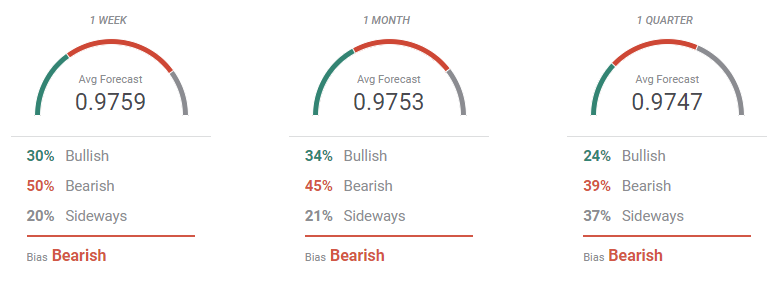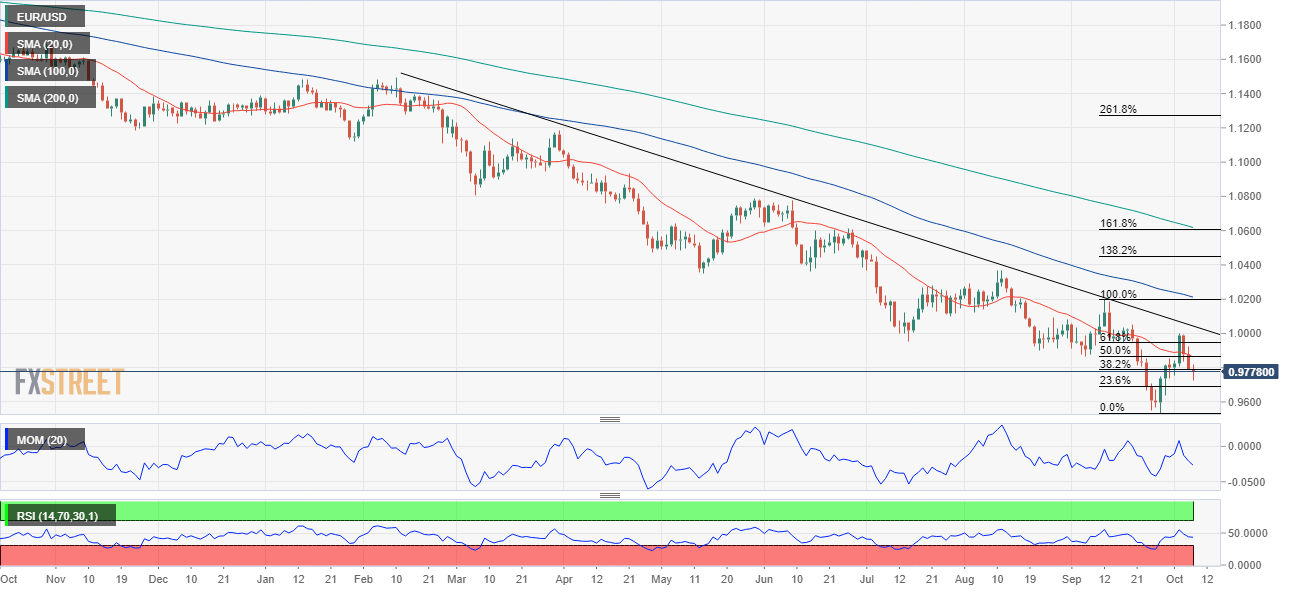- The US Federal Reserve has more 75 bps rate hikes under its sleeve.
- The European Union has little room to avoid a massive recession.
- EUR/USD resumes its dominant bearish trend and aims for fresh 2022 lows.
The EUR/USD pair extended its rally throughout the first half of the week but failed miserably around parity and finished it at around 0.9750, posting a modest weekly loss. Optimism ruled at the beginning of the last quarter of the year, with Wall Street posting whopping gains and government bonds retaining the previous week’s gains.
EUR/USD supported by risk appetite
Risk appetite resulted from market players´ belief that the mounting risk of a global recession would force central banks to slow their pace of quantitative tightening sooner rather than later. The Reserve Bank of Australia hiked the cash rate by 25 bps, less-than-anticipated, fueling such speculation alongside demand for high-yielding assets.
But the upbeat mood did not last long. The shared currency began shedding ground on Wednesday as the EU announced another round of sanctions on Russia due to its invasion of Ukraine in February. Sanctions came after the illegal annexation of Donetsk, Luhansk, Kherson, and Zaporizhzhia regions and included a price cap on Russian oil, alongside restrictions for imports and exports from and to the country.
Trouble looms in the European Union
Additionally, tepid EU data revived concerns of an economic setback in the Union, cooling the risk-positive sentiment. S&P Global downwardly revised its September PMIs, indicating a steeper contraction in the business sector. At the same time, inflation at wholesale levels in the EU soared in August, up by 43.3% YoY, while Retail Sales in the same month were down 0.3% in the month, while German sales fell by 1.3%.
The shared currency was also affected by the European Central Bank Monetary Policy Meeting Accounts. The document showed some officials preferred a wider rate hike of 50 bps. Additionally, the median three-year inflation expectations held at 3%. Policymakers noted that the EUR depreciation could exacerbate inflationary pressures, adding that acting “decisively” now will prevent the need to hike at a more aggressive pace later.
US Federal Reserve officials more hawkish than ever
The market sentiment deteriorated further after US Federal Reserve speakers hit the wires, repeating their well-known hawkish rhetoric. Minneapolis Fed President Neel Kashkari said they have more work to do on inflation, adding that indeed, there is a risk of overshooting but that they are seeing almost no evidence that inflation has peaked. Charles L. Evans, chief executive officer of the Federal Reserve Bank of Chicago, and Cleveland Federal Reserve Bank President Loretta Mester repeated that inflation is their top priority. Finally, Governor Christopher Waller said he sees little reason to ease the pace of Fed policy tightening.
Meanwhile, US data spurred speculation the US Federal Reserve will maintain its aggressive monetary tightening path. The September Nonfarm Payrolls report showed that the country added 265K new jobs in the month, better than anticipated but below the previous. The Unemployment rate unexpectedly shrank to 3.5%, while the Labor Force Participation Rate declined by less-than-anticipated to 62.3% from 62.4% in August. The report came after a row of discouraging US employment figures.
On Tuesday, market players learned that the number of job openings drastically decreased in August, while lay-offs and discharges remained above 1.5 million. Additionally, the Challenger Job Cuts report released on Thursday showed that, in September, US-based employers announced 29,989 cuts, up 46.4% from August and 67.7% higher than a year ago. Finally, Initial Jobless Claims for the week ended September 30 unexpectedly increased to 219K, worse than the 200K anticipated.
Mixed figures still show that the employment sector is strong enough to bear rate hikes.
It’s all about inflation
The upcoming week will have fewer but more interesting scheduled events. The US Federal Reserve will release the Minutes of its latest meeting on Wednesday, while the country will publish the September Consumer Price Index on Thursday. Annual inflation is foreseen up by 8.1%, slightly better than the previous 8.3%. The core reading is foreseen at 6.5%. If it is the case that the CPI eased in August, it would likely have a limited impact on what the market believes the Fed will do. Germany will release the September Harmonized Consumer Price Index, expected to be confirmed at 10.9%. Finally, the focus will be on US September Retail Sales on Friday.

EUR/USD technical outlook
The EUR/USD pair briefly traded above the 61.8% Fibonacci retracement of the 1.0197/0.0535 slide at 0.9945, but it is finishing the week below the 38.2% retracement at 0.9790, which suggests the corrective advance could be over. The pair may well retest and even break below the lower end of the range in the upcoming days.
The weekly chart shows that the pair also faltered just ahead of the daily descending trend line from the year high at 1.1494, which further supports a bearish continuation in the foreseeable future. The 20 SMA maintains a firmly downward slope above the trend line and far below the longer ones. Technical indicators, in the meantime, continue lacking directional strength near oversold readings.
On a daily basis, the risk is skewed to the downside. The pair trades below all of its moving averages, which keep heading south. Technical indicators, in the meantime, resume their declines within negative levels after failing to surpass their midlines.
The 23.6% retracement of the aforementioned daily slump provides immediate support at around 0.9690. The next level to watch is the 0.9600 figure, ahead of the multi-year low of 0.9535.
Sellers will now likely wait at around 0.9870 and 0.9945 ahead of parity. Even if the pair recovers above the latter, it would need to clear the trend line at around 1.0050 to avoid the risk of collapsing.
EUR/USD sentiment poll
The FXStreet Forecast Poll suggests that EUR/USD will likely remain under selling pressure in the following weeks. Bears are a majority in all the time frames under study. On average, the pair is seen stable in the 0.97 area from now until year-end.
The Overview chart paints a gloomy picture for the EUR. The three moving averages head lower, resuming their declines and reaching fresh yearly lows. More relevantly, the monthly and quarterly views show that an increased number of market participants are now foreseeing lower lows for the year sub-0.9500, with potential slides down to 0.9000.

Information on these pages contains forward-looking statements that involve risks and uncertainties. Markets and instruments profiled on this page are for informational purposes only and should not in any way come across as a recommendation to buy or sell in these assets. You should do your own thorough research before making any investment decisions. FXStreet does not in any way guarantee that this information is free from mistakes, errors, or material misstatements. It also does not guarantee that this information is of a timely nature. Investing in Open Markets involves a great deal of risk, including the loss of all or a portion of your investment, as well as emotional distress. All risks, losses and costs associated with investing, including total loss of principal, are your responsibility. The views and opinions expressed in this article are those of the authors and do not necessarily reflect the official policy or position of FXStreet nor its advertisers. The author will not be held responsible for information that is found at the end of links posted on this page.
If not otherwise explicitly mentioned in the body of the article, at the time of writing, the author has no position in any stock mentioned in this article and no business relationship with any company mentioned. The author has not received compensation for writing this article, other than from FXStreet.
FXStreet and the author do not provide personalized recommendations. The author makes no representations as to the accuracy, completeness, or suitability of this information. FXStreet and the author will not be liable for any errors, omissions or any losses, injuries or damages arising from this information and its display or use. Errors and omissions excepted.
The author and FXStreet are not registered investment advisors and nothing in this article is intended to be investment advice.
Recommended Content
Editors’ Picks
EUR/USD stays in positive territory above 1.0850 after US data

EUR/USD clings to modest daily gains above 1.0850 in the second half of the day on Friday. The improving risk mood makes it difficult for the US Dollar to hold its ground after PCE inflation data, helping the pair edge higher ahead of the weekend.
GBP/USD stabilizes above 1.2850 as risk mood improves

GBP/USD maintains recovery momentum and fluctuates above 1.2850 in the American session on Friday. The positive shift seen in risk mood doesn't allow the US Dollar to preserve its strength and supports the pair.
Gold rebounds above $2,380 as US yields stretch lower

Following a quiet European session, Gold gathers bullish momentum and trades decisively higher on the day above $2,380. The benchmark 10-year US Treasury bond yield loses more than 1% on the day after US PCE inflation data, fuelling XAU/USD's upside.
Avalanche price sets for a rally following retest of key support level

Avalanche (AVAX) price bounced off the $26.34 support level to trade at $27.95 as of Friday. Growing on-chain development activity indicates a potential bullish move in the coming days.
The election, Trump's Dollar policy, and the future of the Yen

After an assassination attempt on former President Donald Trump and drop out of President Biden, Kamala Harris has been endorsed as the Democratic candidate to compete against Trump in the upcoming November US presidential election.
